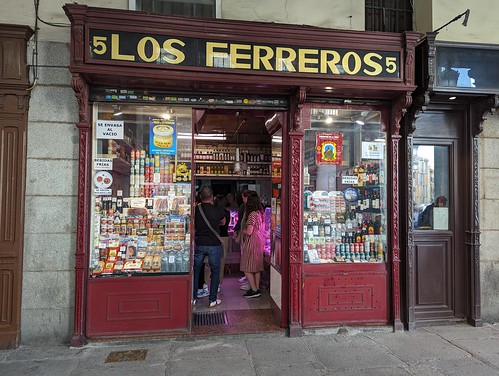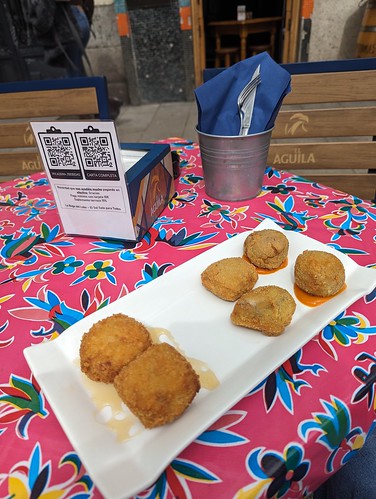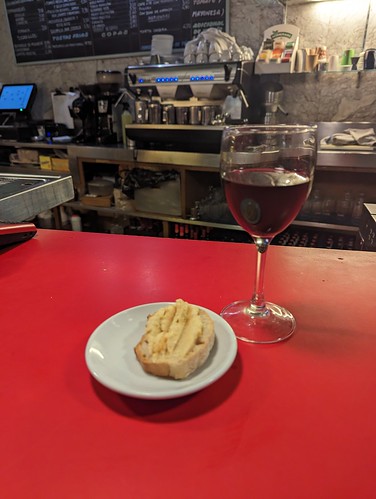As I mentioned in the last post, food tours are a really cool way to learn about a city and a culture while ALSO eating too much. Most of them are active, though, so you have an excuse.
Our first stop was El Riojano for this little cake and a cup full of chocolate. You are supposed to dip the cake and then drink the rest of the chocolate. I could not bring myself to drink the chocolate as it seemed too early in the morning to be that rude.
Our second stop was a complete failure in terms of food but interesting in terms of the city. This is the secret cookie shop. Unfortunately, the sign on the door reads “Hoy no hay dulces” (“Today there are no sweets”). This is a convent and the nuns make a bit of extra cash by making cookies. However, they are not always open, and we had unfortunate timing. Still, interesting stop. You are not allowed to SEE the nuns, which makes buying cookies a small challenge, but the nuns have it figured out. Or so our guide told us, as we didn’t get to witness it.
Next was Los Ferreros, the oldest grocery store in Madrid. It’s been in operation since 1892. The current proprietor is the descendant of the original. We had some delicious cheeses on top of a sort of cracker. We had a moment of unpleasantness – one of the others on the tour decided that the proprietor was riding the coattails of his ancestors and the location and wasn’t really deserving of his continued operation. This was the most embarrassed by American tourists I was during this trip. Luckily the antagonist aggressively spoke no Spanish, the proprietor either didn’t speak English or didn’t listen, and our tour guide softened the challenge when she translated. I had been a little worried when we started the tour as the antagonist had two young boys, maybe 9 and 11? I was worried they would be disruptive but they not only were not disruptive, they were eager to try the food and chatted with the tour guide. It’s too bad their father didn’t take after them.
Spain doesn’t really do street food, and depsite our tour guide insisting that this was the ONE street food they do, I’m not convinced. We stopped at Cerveceria la Campana (C. de Botoneras, 6, Centro, 28012 Madrid, Spain) for a calamari sandwich. It has some aspects of street food – a fried thing in bread – but no one but us was eating on the street. The place was busy with people sitting down, and when we ate, it was clear why – it’s really difficult to eat an overstuffed sandwich when you don’t have a plate. The sandwich was just ok – it was hard to apply the garlic mayo BECAUSE I DIDN’T HAVE A PLATE and without it, I thought the sandwich was under-seasoned. Nevertheless, it’s tough to go wrong with fried seafood.
I will preface this by saying I HATE olives. Hate them. There are very few foods that I hate, and olives are probably the top of the list. But I bravely persevered through our olive tasting. We visited La Queseria de Anton Martin. First was the olive for people who don’t like olives. I didn’t like them. Then I tried another olive that’s supposed to be less olive-y than some, and I didn’t like that either. I stopped there – I gave an honest effort, and this didn’t change my mind about olives.
Next we had anchovies over potato chips. This was much better. Spanish anchovies aren’t the crispy salt-bombs you may be familiar with – it’s a larger piece of fish and prepared by pickling. It’s pretty mild. They served them over a pile of potato chips, kind of like a cheese-less nacho, and they were really nice.
We finished with a vermouth. I have always thought of vermouth as something you put near a glass of gin so you can call it a martini, but drinking it with an orange peel over ice is not unpleasant.
Next stop – Moega empanadas (C. del León, 26, Centro, 28014 Madrid, Spain). These were not a traditional empanada as I’m used to, but they were quite good. The dough was more like a bread. Maybe that’s Spanish and I’m used to Latin American? No matter, because the chorizo and cheese was delightful.
We went to Taberna de la Elisa for croquetas and wine. I used the restroom here and ran into a problem that seems common in Spain – the bathroom lights are on timers, and the timer is set for a time much shorter than your average bathroom break. Two or three times on this trip I was in the restroom and the lights went out, leaving me in a strange place, pitch dark. I survived. The croquetas and wine were very nice, but I didn’t get a photo record.
Our final stop was Estela Hojaldre for dessert pastry. I didn’t catch what it was called, but it was about 1,000 layers of flaky pastry with a custard in the middle. It was, again, not something easy to eat without a table and a plate, but the flavor was excellent and I am a big fan of the texture. Soft custard with layers and layers of crunchy, flaky crust in between. I made a mess of my shirt but it was totally worth it.
I would absolutely do another food tour sponsored by Devour Tours. Our guide was great. She and the other guide had to pivot last minute because there was a group of maybe 12 split across the two tour guides – they switched it up so the large group could go togehter and all of us (me, two couples, and a family of four) shared a tour.
Again, I highly recommend a food tour when you’re in a strange city. You have instant friends. You learn about the local food and culture. And you’ll be well-fed. You can’t go wrong.










